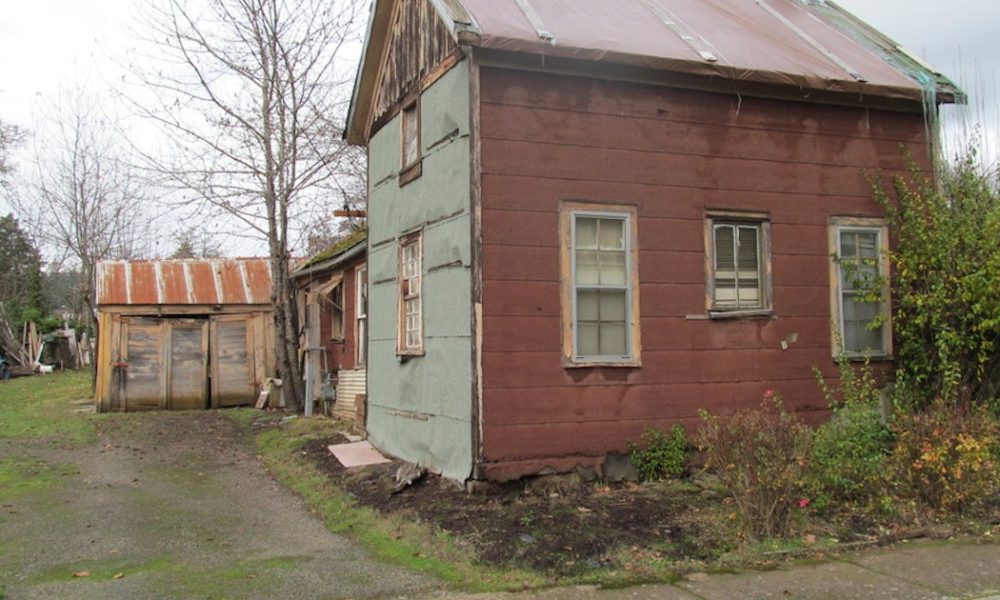 SLABTOWN SURVIVOR, CAMPBELL CHRISMAN’S HOUSE BUILT CIRCA 1873. Photo provided/Dana Merryday
SLABTOWN SURVIVOR, CAMPBELL CHRISMAN’S HOUSE BUILT CIRCA 1873. Photo provided/Dana Merryday
When you think of a ghost town usually it conjures up dusty, bleached out buildings with flapping doors and maybe some tumbleweeds blowing through.
Cottage Grove has a sort of ghost town that looks nothing like that. Our ghost town is on River Road, which runs along the west bank of the Coast Fork of the Willamette River. Starting at Main Street heading south there is a lovely park that hugs the river. There are walking trails, Prospector’s Park with Dr. Snapp’s House and, before it was boarded up due to safety concerns, the Swinging Bridge was a popular destination and travel route. People often stop to feed the ducks and geese who hang out along the banks. On the west side of River Road a few grand old homes stand interspersed with more modern construction. There is little hint that this was once ”Downtown.”
If you could stay put on River Road but turn back the hands of time you would see quite a panorama unfold before your eyes. If you went back far enough, it would only be Kalapuyas fishing or traveling along the river.
Next would come wagons following the Applegate Trail, heading for the promised gold in California. Then we see some of the immigrants stopping and putting down their stakes. Silk Creek was an early locus, as its rushing water was essential to power two necessities for a growing town.
There was also a sawmill to provide lumber, and a gristmill to grind the corn and wheat to feed a large family. Royal Harvey Hazelton was the man with the knowhow and gumption to do both. He built his saw and grist mill on the banks of Silk Creek, and also offered wagon repair services at his shop.
So, along the west bank of the Coast Fork a town began to grow. It didn’t have a name officially but the locals referred to it as ”Slabtown.”
This name came from the rounded outsides of the logs being put through the sawmill. These slabs were incorporated into plank roads and sidewalks to deal with the deep mud that came with the rainy season. Early pedestrians had to watch their step as slabs would come loose and either whack you or toss you into the mud.
Soon quite a bustling town had grown along what was then called Front Street (today’s River Road). There wasn’t any city planning as such. Businesses and houses were just built interspersed together.
In 1867, the name Cottage Grove moved from its location east of Creswell in the form of a Post Office. The Postmaster, Greenbury Pearce, decided to move his business to Slabtown and took the name with him. His cabin, out of which he ran the Post Office, was in an oak grove and he called his Post Office ”Cottage Grove.” Cottage Grove has its roots in Creswell, at least as far as the name goes.
The land on the westside of the Coast Fork was considered better, being a bit higher and less flood prone. But as the the town grew along the river some folks began to brave the muddy east side too.
This would eventually setup a feud that would divide the two sides of town into two separate municipalities, but that is another story. Safe to say most of the business in town was done along Front street.
If you have seen ”The General,” Buster Keaton’s classic film shot in Cottage Grove, you can see a bit of the old Slabtown in the scene when Johnnie Grey goes to enlist.
So where is Slabtown today? Front Street has been renamed to River Road and one by one the businesses, which were at first successful, died out or moved over to the growing east side.
The railroad was the deciding factor for which side of town was due to prosper. When the tracks were laid on the eastern side, Slabtown’s days were numbered. Gradually the abandoned businesses were replaced with residences, and today it’s very hard to imagine that this was once the center of town.
There are several homes that date from Slabtown’s glory days, plus Dr. Snapp’s House that has been relocated from where Riverview Terraces now stand. The Old Mill Farm Store, which is the longest continuously operated business in Lane county, still sits where the old Hazelton Mill was located, although fires through the years have erased the original structures and their replacements.
But on a quiet day with no traffic, if you squint your ears, you may be able to hear teamsters urging their horses to pull through the mud, the riotous miners whooping it up in one of Jefferson Mackley’s Saloons or some other whisper of Cottage Grove’s Ghost Town as the old Coast Fork flows along, same as it ever was.
Dana Merryday can be reached at: 541-942-7037, 205 Adams Ave, Cottage Grove, [email protected]








